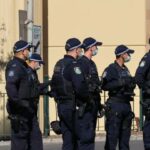Police Want Power to Ram Cars During High-Speed Pursuits

.
Western Australia police are demanding the power to ram cars they’re pursuing, without having to face legal repercussions if the action results in death.
At a press conference last Thursday, George Tilbury, president of the WA Police Union, called on the Barnett government to introduce legislation allowing police to “nudge” a vehicle off the road, claiming it will “protect innocent members of the community and police officers.”
The crash that can be avoided
The push comes in response to a high-speed pursuit that ended in a fatal crash on September 17.
A 16-year-old boy, who’d been pursued by police, crashed the Ford Falcon he was driving into a Nissan Pulsar at an intersection on Warwick Road in the Perth suburb of Greenwood.
Police began to pursue the vehicle when the driver refused to pull over, but they aborted the chase when the car began driving erratically.
A 60-year-old woman died at the scene and her 66-year-old husband lost his fight for life later in hospital. Their 25-year-old son, who was driving the car, was admitted to hospital in a critical condition.
WA police protocol
WA deputy police commissioner Stephen Brown said the two officers who engaged in the pursuit were following standard protocol.
The current policy in WA requires officers to get permission from an Inspector or higher ranked officer to start a pursuit. Police must cease a chase if vehicles pass certain speeds. From that point, police endeavour to track the car from the air, or use any intelligence gathered to later apprehend the culprit.
The PIT manoeuvre
Tilbury believes the crash could have been avoided if police were able to perform the precision immobilisation technique, or ‘PIT’ manoeuvre.
This controversial technique – which is not permitted anywhere in Australia – allows police to bump into the rear side of a vehicle, causing it to spin out of control.
And despite its illegality, Tilbury said police are already utilising the manoeuvre here. He pointed to an incident on September 14, when police chased 38-year-old Danny Jay Brooks through the streets of Perth’s southern suburbs, after he had escaped from Freemantle police station.
The hour-long chase was brought to an end when police rammed the rear of his vehicle, causing Brooks to lose control. Other police cars then boxed him in.
However, acting WA police commissioner, Gary Dreibergs, said using the PIT manoeuvre is risky and safety should be the priority. He reasoned young people could be in a vehicle that was rammed and “regardless of what they’ve been doing,” you don’t want them to die.
The death of Sharon Ann D’Ercole
The debate surrounding police pursuits in WA has been going on for years.
On September 13 this year, WA Coroner Evelyn Vicker handed down her findings into the death of 50-year-old Sharon Ann D’Ercole, who was killed in April 2012 when a police officer hit her car as police drove through a red light in pursuit of another vehicle.
The coroner concluded Ms D’Ercole’s death was an accident, but added she couldn’t find otherwise, as the driver of the vehicle that hit her, Constable Gareth Hopley, had already been found not guilty of dangerous driving causing death in November 2013.
In response to the incident, WA police voted to ban all high-speed pursuits in June 2012, unless the government passed laws to prevent police being prosecuted if a chase results in a death or injury.
Changes to WA laws
The Barnett government responded by passing the Road Traffic (Miscellaneous Amendments) Bill in November 2012.
The legislation established a new defence for police that applies if an officer is driving on official duty, acting in accordance with standard protocol and driving “reasonably” under the circumstances.
The bill also introduced mandatory sentences for drivers that police pursue.
A person found guilty of dangerous driving causing bodily harm while trying to escape police is given a mandatory minimum sentence of six months’ imprisonment, and if a chase results in a death or serious injury, the mandatory minimum is twelve months.
The number of police pursuits in WA has more than tripled over the past five years, from 322 in 2010 to 1,029 in 2015.
Deaths resulting from police pursuits in Australia
A 2013 Australian Institute of Criminology report found that between 2000 and 2011, there were 185 pursuit-related crashes resulting in 218 fatalities in Australia – an average of around 15 crashes a year and 18 deaths per year.
The study further found that of the 218 deaths, 110 were the alleged offenders who were driving a car, and 26 were alleged offenders who were passengers. The remaining 82 were innocent people:
37 were passengers in cars being pursued and 45 were bystanders or road users, including six police officers.
Around the nation
But while WA police are calling for enhanced more powers and protections, elsewhere in the country the validity of chasing vehicles at high speeds through busy streets has been questioned.
In Tasmania, reforms to high-speed pursuits have long been in place. In 1999, the state passed a ban on pursuits for minor offences – such as traffic offences – which has resulted in deaths and injuries being almost eliminated.
A similar 2012 ban in Queensland has had the same effect.
The Victorian example
In June last year, Victoria police pursuit policy was amended so police can only chase vehicles in exceptional circumstances.
Victorian police can now initiate a pursuit only if it’s necessary to prevent serious risk to public health and safety, or if a criminal offence has been or is about to be committed that involves serious injury to a person.
In addition, police can conduct pursuits if there are no alternatives to apprehending a vehicle’s occupants, and where the overall harm police are seeking to prevent is greater than the risks involved in the chase.
In NSW
Despite a renewed push from legal groups and the community for changes to the NSW’s police pursuit policy earlier this year, reform has not occurred.
The calls came after a high-speed pursuit in Sydney’s Marayong left three people dead and two injured.
Five years ago, NSW police were tasked with conducting a review of their Safe Driving Policy – which governs how they conduct pursuits – with the aim of improving road safety.
However, the results of the review have still not been released.
Going to court for a traffic offence?
If you are going to court for a traffic offence, call or email Sydney Criminal Lawyers anytime to arrange a free first consultation with an experienced, specialist traffic lawyer who will accurately advise you of your options, the best way forward, and fight for the optimal outcome in your specific situation.
Image credit: Science Poll.com








